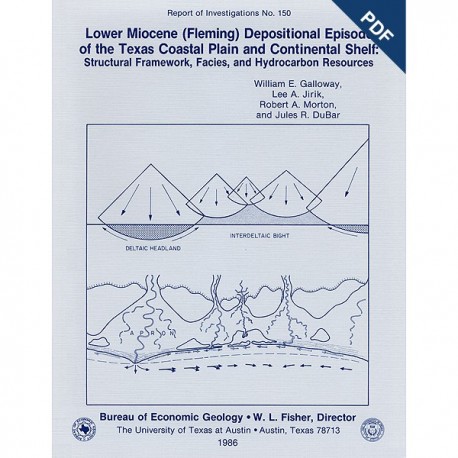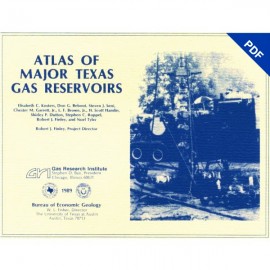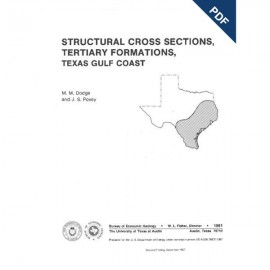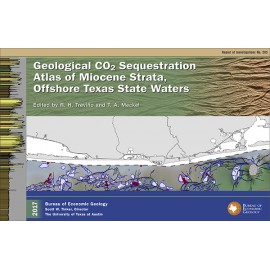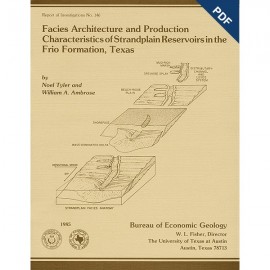Reports of Investigations
-
Books & Reports
- Reports of Investigations
- Guidebooks
- Udden Series
- Geological Circulars
- Down To Earth
- Atlases of Major Oil and Gas Reservoirs
- Texas Memorial Museum Publications
- Environmental Geologic Atlas of the Texas Coastal Zone
- Mineral Resource Circulars
- Other Reports
- Seminars and Workshops
- Handbooks
- Submerged Lands of Texas
- Symposia
- Annual Reports
- Open File Reports
-
Maps & Cross Sections
- Thematic Maps
- Miscellaneous Maps, Charts & Sections
- Geologic Atlas of Texas
- STATEMAP Project Maps
- Geologic Quadrangle Maps
- Cross Sections
- Highway Geology Map
- Energy and Mineral Resource Maps
- Shoreline Change and Other Posters
- Wilcox Group, East Texas, Geological / Hydrological Folios
- Bouguer Gravity Atlas of Texas
- River Basin Regional Studies
- Featured Maps
- Posters
- Teachers & the Public
-
Geological Society Publications
- Gulf Coast Association of Geological Societies
- Alabama Geological Society
- Austin Geological Society
- Corpus Christi Geological Society
- Houston Geological Society
- Lafayette Geological Society
- Mississippi Geological Society
- New Orleans Geological Society
- South Texas Geological Society
- GCS SEPM Publications
- Historic BEG & UT Series
Lower Miocene (Fleming) Depositional Episode of the Texas Coastal Plain and Continental Shelf: ...Digital Download
RI0150D
A free, digital version of this publication can be found on: Texas ScholarWorks
To purchase a print version (if available): RI0150
RI0150D. Lower Miocene (Fleming) Depositional Episode of the Texas Coastal Plain and Continental Shelf: Structural Framework, Facies, and Hydrocarbon Resources, by W. E. Galloway, L. A. Jirik, R. A. Morton, and J. R. DuBar. 50 p., 20 figs., 4 tables, 1 appendix, 7 plates, 1986. doi.org/10.23867/RI0150D. Downloadable PDF.
To purchase this publication in book format, please order RI0150.
ABSTRACT
The Fleming Group and its basinward equivalents constitute the stratigraphic record of one of the major Cenozoic depositional episodes of the northern Gulf Coast Basin. The depositional sequence representing the episode is bounded above by the Amphistegina B shale and below by the Anahuac shale. Initially, lower Miocene (Oakville) progradation advanced across the broad submerged shelf platform constructed during earlier Frio deposition. When outbuilding reached the Frio paleocontinental margin, the rate slowed as large-scale growth faulting created a narrow lower Miocene expansion zone. The later portion of the lower Miocene episode, generally equivalent to the Lagarto Formation, was characterized by long-term shoreline stability and retreat punctuated by local, temporary progradation.
In South Texas, the lower Miocene depositional framework includes the Santa Cruz fluvial system and the North Padre delta system. The bed-load fluvial complex fed a wave-dominated delta, constructing a broadly convex deltaic headland across the foundered Frio Norias delta system. Extensive wave reworking and longshore transport of sand and mud nourished a broad barrier island/ lagoon and strandplain complex that extended along the central and much of the northeastern Texas coast. This well-known barrier/strandplain system was bounded updip by a coastal plain traversed by numerous, small, intrabasinal streams. Near the present Sabine River, westernmost deposits of a continental-scale mixed-load fluvial and equivalent delta system extend beneath the Texas Coastal Plain and shelf from the Miocene depocenter in Louisiana. Here, the early phase of lower Miocene progradation was also complicated by the incision and filling of numerous submarine gorges.
Lower Miocene reservoirs have produced nearly 4 billion barrels of oil equivalent of petroleum from nine identified plays in the Texas Coastal Plain and shelf. The most prolific play, the Houston Embayment salt domes, accounts for nearly all the oil and more than two-thirds of the total production from deposits of the episode. Four offshore plays offer the greatest area for discovery of substantial new reserves, primarily of gas. To date, however, the yield per volume of reservoir sandstone for Miocene plays remains low relative to more prolific units, such as the Frio Formation.
Keywords: Fleming, Oakville, lower Miocene, petroleum (oil and gas), depositional system
Contents
Abstract
Introduction
Stratigraphic nomenclature and zonation
Depositional setting
Episode boundaries, correlation, and operational map units
Objectives
Structural Framework
Reactivated structures
Contemporaneous structures
Lower Miocene Depositional Framework
Sources of data
Lower Miocene depositional systems
Santa Cruz fluvial' system
North Padre delta system
Moulton/Point Blank streamplain
Matagorda barrier/strandplain system
Newton fluvial system
Calcasieu delta system
Depositional history and paleogeography
Origin and Distribution of Hydrocarbons
Indigenous source rocks and maturation history
Migration and entrapment
Occurrence of oil and gas
General features of lower Miocene plays
Exploration potential
Onshore and State submerged lands
Outer Continental Shelf
Conclusions
Acknowledgments
References
Appendix: Tabulation of fields by play
Figures
1. Gulf Coast Cenozoic depositional episodes
2. Lithostratigraphic and biostratigraphic subdivision of the lower Miocene section, Northwest Shelf of the Gulf of Mexico
3. Index map and depositional framework of the lower Miocene (Fleming) depositional episode
4. Schematic reconstruction of the stratigraphic architecture of a Gulf Coast Cenozoic depositional sequence
5. Electric log response of typical facies sequences within the depositional complex of a Gulf Coast Cenozoic episode
6. Schematic cross section of the lower Miocene depositional sequence, Texas Coastal Plain and shelf, showing the lithostratigraphic and biostratigraphic features used for correlation
7. Structural framework of the lower Miocene sequence
8. Net-sandstone isopach map of the Oakville (Anahuac shale to Marginulina a.) operational unit
9. Percent-sandstone map of the Oakville (Anahuac shale to Marginulina a.) operational unit
10. Net-sandstone isopach map of the Lagarto (Marginulina a.to Amphistegina B shale) operational unit
11. Percent-sandstone map of the Lagarto (Marginulina a. to Amphistegina B shale) operational unit
12. Generalized paleobathymetry of Oakville and Lagarto map interval mudstones
13. Lower Miocene depositional systems and their component elements
14. Paleogeographic reconstruction during later Oakville progradation and middle Lagarto coastal plain aggradation
15. Interpretive morphologic profiles across the lower Miocene coastal plain, shoreline, shelf, and slope
16. Depositional architecture of the lower Miocene coastal plain and shoreline
17. Distribution of lower Miocene oil and gas fields that have produced more than 1 million boe of hydrocarbons
18. Cumulative oil and gas production for each of the nine lower Miocene plays
19. Total hydrocarbon yield factors calculated on the basis of estimated total rock volume and total sandstone volumecontained within each of the nine Miocene plays
20. Distribution of total producible reserves in 32 Miocene fields in Federal OCS areas
Tables
1. Total organic carbon content of lower Miocene mudstones
2. Summary of geologic characteristics and remaining potential of lower Miocene oil and gas plays
3. Cumulative production and sedimentary volumes of lower Miocene plays
4. Projected volumes of undiscovered recoverable hydrocarbons
Plates (in pocket of book)
I. Structural cross section 1-1'
II. Structural cross section 12-12'
III. Structural cross section 19-19'
IV. Net-sandstone isopach map, Oakville operational unit
V. Percent-sandstone map, Oakville operational unit
VI. Net-sandstone isopach map, Lagarto operational unit
VII. Percent-sandstone map, Lagarto operational unit
Citation
Galloway, W. E., Jirik, L. A., Morton, R. A., and DuBar, J. R., 1986, Lower Miocene (Fleming) Depositional Episode of the Texas Coastal Plain and Continental Shelf: Structural Framework, Facies, and Hydrocarbon Resources: The University of Texas at Austin, Bureau of Economic Geology, Report of Investigations No. 150, 50 p.
